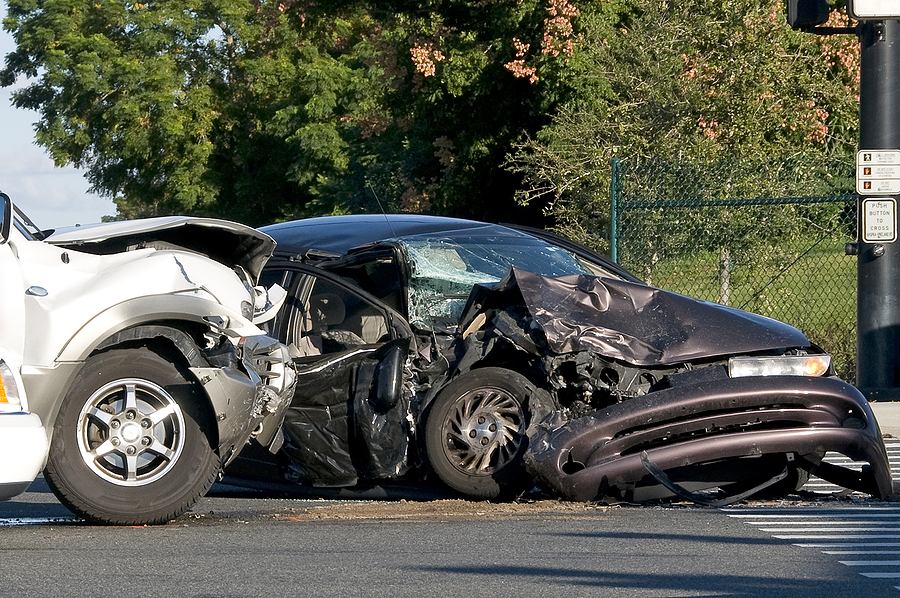
Whether a motor vehicle driver is running a simple errand or taking a long road trip, it is almost certain that they will pass through one or more intersections at some point along the way. Although many intersections have traffic control devices in place, such as stop signs and traffic lights, and despite crash avoidance mechanisms on newer vehicles, serious accidents can occur at these intersections. Many times, these accidents are due to negligent and careless driving.
Broadside accidents, otherwise known as T-bone accidents, typically occur at traffic intersections, but they can take place at other locations as well. If you or a person you love has suffered injuries in a broadside accident due to another driver’s negligence, you may be eligible to pursue and recover monetary compensation for your injuries. An experienced car accident attorney in your jurisdiction can review the facts of your case and may seek monetary compensation on your behalf.
What Happens in a Broadside Accident?
A broadside—or T-bone—accident occurs when the front or rear of a motor vehicle collides with the side of another vehicle. When one of these accidents occurs, the stopped motor vehicles often resemble the shape of a “T,” hence the name T-bone accident.
According to statistics provided by the National Highway Traffic Safety Administration, more than two million motor vehicle collisions take place at traffic intersections each year. Broadside accidents are most common at traffic intersections, since motor vehicles are often coming from several different directions at these locations.
In addition to intersections, broadside accidents can also occur at a highway exit or on-ramp, on roadways that have several lanes, and at intersections in rural areas where only one traffic direction has a yield sign or a stop sign.
Why Do Broadside Traffic Accidents Typically Occur?
Traffic accidents occur regularly throughout the country, but more frequently at traffic intersections. Although many new motor vehicles today are equipped with the latest safety mechanisms on board, many of these features do little to prevent a motor vehicle operator or passenger from sustaining injuries when a broadside accident occurs.
In many instances, T-bone accidents occur because of negligence on the part of another motor vehicle operator.
Some of the most common types of driver negligence that can lead to a T-bone motor vehicle accident include:
- Failing to follow traffic control devices – Traffic control devices, like stop signs and traffic lights, are present at intersections to keep people safe. However, many drivers will try to beat a red light to get through the traffic intersection without having to wait. When drivers disregard traffic control devices or try to get through an intersection quickly, traffic from perpendicular lanes of travel may enter the intersection at the same time. The speeding driver then collides with one of the vehicles entering the intersection, resulting in a terrible impact. In the most severe T-bone accident cases, a negligent driver can begin a chain reaction collision that involves multiple vehicles, accident victims, and injuries, not to mention property damage.
- Not yielding the right-of-way to other traffic – Drivers who change lanes or wish to make turns are responsible for looking around, assessing the situation, and making sure that it is safe to do so. When a driver does not stay aware of their surroundings and look around before turning or switching lanes, they may negligently cause a collision with a vehicle that has the right of way. In some instances, these types of broadside collisions may force a vehicle into oncoming traffic, making an already bad situation much worse.
- Engaging in distracted driving – It is against the law in most jurisdictions for motor vehicle operators to drive their vehicles while using a cell phone or other electronic device to send text messages, emails, or make phone calls without the use of a hands-free device. These hands-free laws try to ensure that drivers give 100 percent of their attention to the road while they are behind the wheel of a vehicle. When a driver has to look down to send or respond to a text, they may not see another vehicle coming, and that can lead to substantial impacts and serious injuries.
- Operating a motor vehicle while under the influence of drugs or alcohol – In most jurisdictions, the legal driving limit is a blood alcohol concentration (BAC) of 0.08 percent. The BAC limit for commercial drivers is often much lower, and most jurisdictions have a zero-tolerance policy in effect for minors (those individuals who are under 21 years of age at the time of the accident). Drug and alcohol intoxication impairs a driver’s reaction time and awareness. When it comes to broadside accidents, an impaired driver may not have the ability to apply the brakes before they collide with another motor vehicle, resulting in a car accident with serious injuries.
If you or someone you love has suffered one or more injuries in a broadside accident that someone else caused, you should talk to a knowledgeable car accident lawyer in your jurisdiction as soon as possible. Your attorney can help you determine if you have a valid cause of action. If so, they can assist you with filing a claim or lawsuit against the driver who was responsible for your broadside accident.
Common Injuries That Accident Victims Sustain in Broadside Car Accidents
Broadside car accidents can result in extremely serious and debilitating personal injuries. As a result of the injuries you sustain in an accident, you may need to undergo medical treatment or attend physical therapy sessions, as well as other medical procedures, such as injections or surgeries, depending upon your specific injuries. Broadside accidents produce terrible injuries because the impact typically occurs in an area of the car where there are few safety features. These accidents also usually happen with a serious amount of force, significantly increasing the likelihood that the vehicle occupants will sustain injuries.
Some of the most common injuries that can result from broadside motor vehicle collisions include:
- Broken bones – When an impact causes part of a driver or passenger’s body to forcefully strike the inside of the vehicle, such as the console or a window, they may sustain a bone fracture that may require surgery to correct.
- Traumatic head and brain injuries – A traumatic brain injury, also known as a TBI, occurs when a driver or passenger strikes their head on the steering wheel, window, or headrest. These injuries usually result in disruption to the brain’s neurons and axons. Some TBIs are mild, such as a minor concussion. However, other TBI’s are much more serious and can result in long-term memory losses, a permanent coma or vegetative state, and even death.
- Spinal cord injury – A severe spinal cord injury can occur when a motor vehicle occupant severs a spinal nerve (or a group of nerves) or snaps their spine in an accident. In the most serious accident cases, a spinal cord injury can lead to full or partial paralysis that leaves the accident victim unable to move.
- Soft tissue injuries – Soft tissue injuries are injuries to muscles or muscle groups. Although these injuries do not involve a broken bone, they can still be serious and extremely painful. These accidents most often occur to the neck, upper back, or shoulder, and result from a whiplash-type movement that takes place during the accident.
According to recent statistics from the National Highway Traffic Safety Administration (NHTSA), more than 34,000 individuals died in one year as a result of motor vehicle accidents. In some particularly severe broadside collisions, the accident may result in the death of one or both motor vehicle operators and their passengers.
When that happens, depending upon the jurisdiction, the decedent’s surviving family members may file a wrongful death claim or lawsuit against the motor vehicle driver who caused the broadside accident. In some jurisdictions, the decedent’s survivors will first need to open an estate and have a personal representative appointed. That individual can then file a wrongful death claim against the at-fault driver.
Filing a Claim or Lawsuit Following Your Broadside Accident
If you have suffered injuries in a broadside car accident that was not your fault, you may bring a claim against the at-fault driver’s motor vehicle insurance company in most jurisdictions.
As part of your claim, you may pursue monetary compensation for the injuries that you sustained in the accident. After you finish all of your medical treatment and physical therapy, a car accident lawyer in your jurisdiction can gather your medical documentation and submit it to the at-fault driver’s insurance company for review.
After some negotiations, your case may settle. When it comes to settling a car accident case, the decision is ultimately yours. Your lawyer can help you decide whether a particular settlement offer is worth accepting in your case.
It is essential to know that insurance companies are generally not interested in doing the right thing or the fair thing. Instead, their primary goal is to settle your car accident claim for as little money as possible. If, after some negotiations, the insurance company still refuses to compensate you fully and fairly for your injuries, your lawyer may need to file a lawsuit in your case. The suit is typically against the driver who caused your accident.
Regardless of whether or not your attorney files a lawsuit arising out of your broadside accident, in most fault-based jurisdictions, there are certain legal elements that you will need to prove to recover monetary compensation for your injuries.
Specifically, you will need to demonstrate that:
- The other driver owed you a duty of care to operate their motor vehicle safely and carefully.
- The other driver breached that duty of care by violating one or more traffic laws. For example, the other driver may have run a red light or stop sign or may have engaged in distracted driving, such as by sending a text message or email while operating their vehicle.
- The at-fault driver’s negligence caused the accident that resulted in your injuries.
- Your injuries directly resulted from the car accident, or the accident exacerbated a pre-existing medical condition or illness.
An experienced broadside car accident lawyer in your jurisdiction can assist you with proving the legal elements of your car accident case, increasing the chances that you will receive full and fair compensation for the injuries that you sustained.
Types of Recoverable Compensation in Broadside Accident Cases
There are several types of monetary compensation that you may recover in a broadside accident case.
Depending upon the nature and extent of your injuries, and whether or not those injuries are permanent, you may file a claim for these damages:
- Compensation for all of your medical, physical therapy, and surgical bills
- Compensation for lost earnings if you had to miss time at work due to your injuries
- Compensation for all of the inconvenience, pain, and suffering that you endured following your accident
- Compensation for loss of enjoyment of life or loss of use of a body part, if you sustained a permanent injury in your accident
- Compensation that represents the anticipated costs of future medical procedures or lifetime care costs at an extended care facility
- Compensation for mental distress and emotional anguish resulting from your accident, including post-traumatic stress disorder (PTSD)
If you have a loved one who died in a broadside accident, you may open a wrongful death claim on behalf of your deceased loved one. As part of the wrongful death claim, depending upon your jurisdiction, you may pursue monetary compensation for future lost earnings if the decedent was the primary breadwinner, loss of companionship of the decedent, and pain and suffering damage for the time between the accident up until the decedent’s untimely death.














